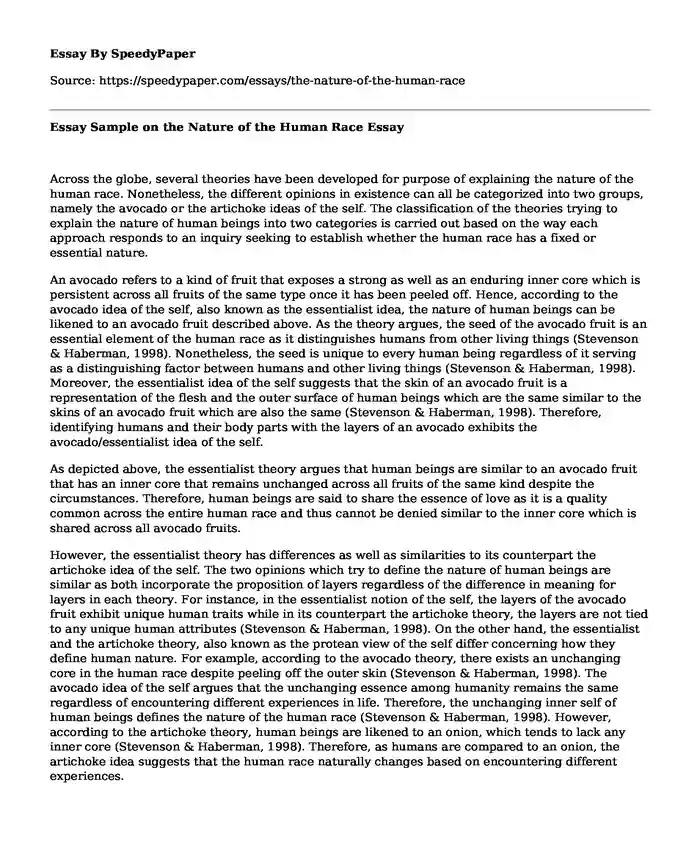
| Type of paper: | Essay |
| Categories: | Race Religion Human Human development |
| Pages: | 3 |
| Wordcount: | 656 words |
Across the globe, several theories have been developed for purpose of explaining the nature of the human race. Nonetheless, the different opinions in existence can all be categorized into two groups, namely the avocado or the artichoke ideas of the self. The classification of the theories trying to explain the nature of human beings into two categories is carried out based on the way each approach responds to an inquiry seeking to establish whether the human race has a fixed or essential nature.
An avocado refers to a kind of fruit that exposes a strong as well as an enduring inner core which is persistent across all fruits of the same type once it has been peeled off. Hence, according to the avocado idea of the self, also known as the essentialist idea, the nature of human beings can be likened to an avocado fruit described above. As the theory argues, the seed of the avocado fruit is an essential element of the human race as it distinguishes humans from other living things (Stevenson & Haberman, 1998). Nonetheless, the seed is unique to every human being regardless of it serving as a distinguishing factor between humans and other living things (Stevenson & Haberman, 1998). Moreover, the essentialist idea of the self suggests that the skin of an avocado fruit is a representation of the flesh and the outer surface of human beings which are the same similar to the skins of an avocado fruit which are also the same (Stevenson & Haberman, 1998). Therefore, identifying humans and their body parts with the layers of an avocado exhibits the avocado/essentialist idea of the self.
As depicted above, the essentialist theory argues that human beings are similar to an avocado fruit that has an inner core that remains unchanged across all fruits of the same kind despite the circumstances. Therefore, human beings are said to share the essence of love as it is a quality common across the entire human race and thus cannot be denied similar to the inner core which is shared across all avocado fruits.
However, the essentialist theory has differences as well as similarities to its counterpart the artichoke idea of the self. The two opinions which try to define the nature of human beings are similar as both incorporate the proposition of layers regardless of the difference in meaning for layers in each theory. For instance, in the essentialist notion of the self, the layers of the avocado fruit exhibit unique human traits while in its counterpart the artichoke theory, the layers are not tied to any unique human attributes (Stevenson & Haberman, 1998). On the other hand, the essentialist and the artichoke theory, also known as the protean view of the self differ concerning how they define human nature. For example, according to the avocado theory, there exists an unchanging core in the human race despite peeling off the outer skin (Stevenson & Haberman, 1998). The avocado idea of the self argues that the unchanging essence among humanity remains the same regardless of encountering different experiences in life. Therefore, the unchanging inner self of human beings defines the nature of the human race (Stevenson & Haberman, 1998). However, according to the artichoke theory, human beings are likened to an onion, which tends to lack any inner core (Stevenson & Haberman, 1998). Therefore, as humans are compared to an onion, the artichoke idea suggests that the human race naturally changes based on encountering different experiences.
Hence, in conclusion, as the avocado theory defines human nature and depicts religious perspectives, it is possible to establish the relationship between human and divine nature whereby one gathers as the other distributes. Human nature such as love is a created element that can be easily destroyed contrary to the divine nature, which is neither created thus cannot change.
References
Stevenson, L., & Haberman, D. L. (1998). Ten theories of human nature. Oxford University Press. Retrieved from https://psycnet.apa.org/record/1998-07825-000
Cite this page
Essay Sample on the Nature of the Human Race. (2023, Jan 09). Retrieved from https://speedypaper.net/essays/the-nature-of-the-human-race
Request Removal
If you are the original author of this essay and no longer wish to have it published on the SpeedyPaper website, please click below to request its removal:
- HRM Essay Example: Best and Worst Bosses
- Failure Essay Example
- Economics Paper Sample: Answer Questions
- Scholarship Essay Example
- Free Essay on How the Book The Constitution Cafe Changed My Views on Our Constitution and Government
- SDLC Methodologies Essay Sample
- Free Essay Example: Events that Affected Minorities and Sports
Popular categories




